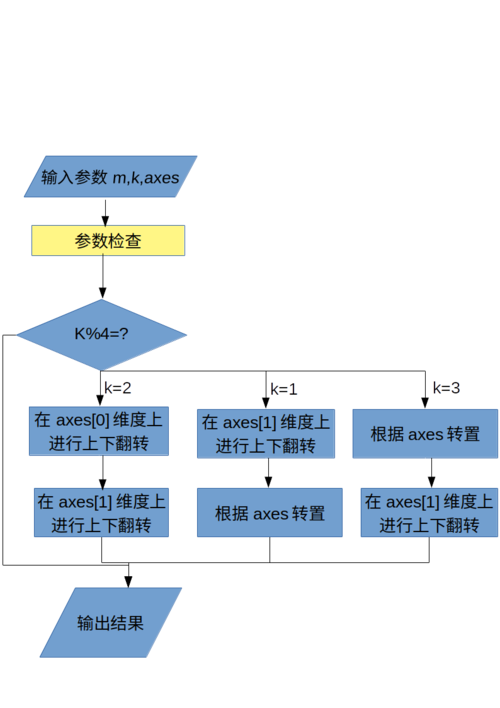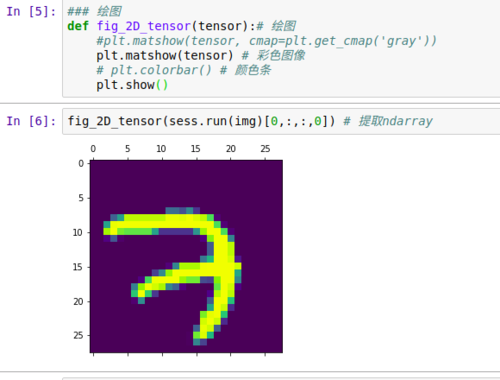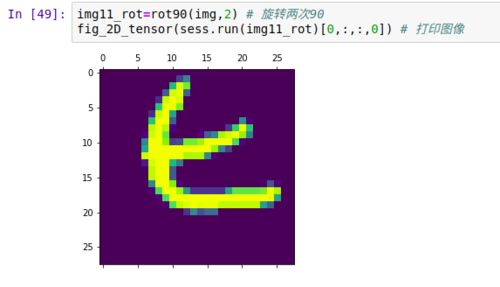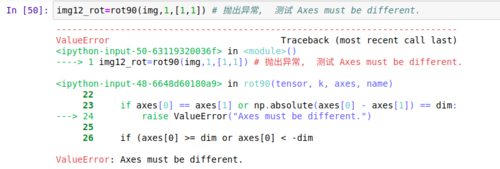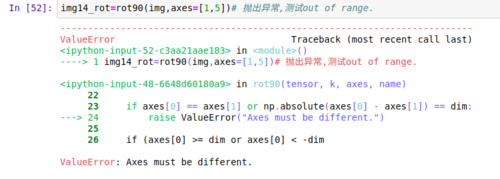tensorflow 旋转矩阵的函数实现方法
关键字: rot90, tensorflow
1. 背景
在做数据增强的操作过程中, 很多情况需要对图像旋转和平移等操作, 针对一些特殊的卷积(garbo conv)操作,还需要对卷积核进行旋转操作.
在tensorflow中似乎没有实现对4D tensor的旋转操作.
严格的说: tensorflow对tensor的翻转操作并未实现, 仅有针对3D tensor的tf.image.rot()
而在大多数的情况下使用的是4D形式的tensor, [B,W,H,C] 或者是3D的图像组成的batchs.
通过查看这篇文章的代码可以知道1 可以使用numpy的rot90()函数旋转, 但是rot90对象是ndarray, 针对tensorflow.tensor对象而言显然是无法使用的, 会抛出类似: 无法找到m.dim属性的异常.
也就是说无法使用numpy.rot90() 函数.
又知, tensorflow中提供有对矩阵的翻转, 转置,切片操作的函数,但是没有提供旋转90°, 180°,270°的操作.
因此可以参照numpy.rot90(m, k=1, axes=(0,1))的程序片段去自己动手实现.
rot90中的第一个参数m是操作对象, k是旋转的次数,k=1 代表逆时针旋转90度, k=2 代表逆时针旋转180度,以此类推
axes是代表旋转的操作在哪两个维度构成的平面上.
rot90的源代码如下:
def rot90(m, k=1, axes=(0,1)): ''' ...... ''' # 省略检测参数的操作 k %= 4 if k == 0: return m[:] if k == 2: return flip(flip(m, axes[0]), axes[1]) axes_list = arange(0, m.ndim) (axes_list[axes[0]], axes_list[axes[1]]) = (axes_list[axes[1]], axes_list[axes[0]]) if k == 1: return transpose(flip(m,axes[1]), axes_list) else: # k == 3 return flip(transpose(m, axes_list), axes[1])
PS: 通过阅读上述的代码,也可以发现在tensorflow中直接使用rot90所抛出的异常是在这里出现的
if axes[0] == axes[1] or absolute(axes[0] - axes[1]) == m.ndim
原因是: 程序把tensor对象当成np.ndarray操作了, 而tensor对象没有m.dim属性
2. 实现rot90操作
2.1 梳理程序流程
通过查看源代码可以梳理出程序流程图:
2.2 tensorflow 实现旋转操作
根据上述的流程图, 可以实现对tensorflow的rot90操作;
def rot90(tensor,k=1,axes=[1,2],name=None):
'''
autor:lizh
tensor: a tensor 4 or more dimensions
k: integer, Number of times the array is rotated by 90 degrees.
axes: (2,) array_like
The array is rotated in the plane defined by the axes.
Axes must be different.
-----
Returns
-------
tensor : tf.tensor
A rotated view of `tensor`.
See Also: https://www.tensorflow.org/api_docs/python/tf/image/rot90
'''
axes = tuple(axes) if len(axes) != 2: raise ValueError("len(axes) must be 2.")
tenor_shape = (tensor.get_shape().as_list())
dim = len(tenor_shape)
if axes[0] == axes[1] or np.absolute(axes[0] - axes[1]) == dim: raise ValueError("Axes must be different.")
if (axes[0] >= dim or axes[0] < -dim
or axes[1] >= dim or axes[1] < -dim):
raise ValueError("Axes={} out of range for tensor of ndim={}."
.format(axes, dim))
k%=4
if k==0: return tensor if k==2:
img180 = tf.reverse(tf.reverse(tensor, axis=[axes[0]]),axis=[axes[1]],name=name) return img180
axes_list = np.arange(0, dim)
(axes_list[axes[0]], axes_list[axes[1]]) = (axes_list[axes[1]],axes_list[axes[0]]) # 替换
print(axes_list) if k==1:
img90=tf.transpose(tf.reverse(tensor,axis=[axes[1]]), perm=axes_list, name=name) return img90 if k==3:
img270=tf.reverse( tf.transpose(tensor, perm=axes_list),axis=[axes[1]],name=name) return img2702.3 代码测试
# 加载库import numpy as npimport matplotlib.pyplot as pltimport tensorflow as tf# 手写体数据集 加载from tensorflow.examples.tutorials.mnist import input_data
mnist = input_data.read_data_sets("/home/lizhen/data/MNIST/", one_hot=True)
sess=tf.Session()#选取数据 4Dimages = mnist.train.images
img_raw = images[0,:] # [0,784]img=tf.reshape(img_raw,[-1,28,28,1]) # img 现在是tensor# 绘图def fig_2D_tensor(tensor):# 绘图
#plt.matshow(tensor, cmap=plt.get_cmap('gray'))
plt.matshow(tensor) # 彩色图像
# plt.colorbar() # 颜色条
plt.show()# 显 显示 待旋转的图片fig_2D_tensor(sess.run(img)[0,:,:,0]) # 提取ndarray简单的测试一下代码:
img11_rot=rot90(img,2) # 旋转两次90fig_2D_tensor(sess.run(img11_rot)[0,:,:,0]) # 打印图像img12_rot=rot90(img,1,[1,1]) # 抛出异常, 测试 Axes must be different.img13_rot=rot90(img,1,[0,6]) # 抛出异常, 测试 Axes must be different.img14_rot=rot90(img,axes=[1,5])# 抛出异常,测试out of range.img14_rot=rot90(img,axes=[-1,2]) # -1的下标是倒数第二个,测试out of range.
测试结果:
3总结
okey了,现在可以用了.
.....
额,,,,,最近才发现tensorflow的最新版本,大约就在前几天发布的新版本(14天前, 1.10.1 )上已经添加了对2D,3D图像的操作,支持[B,W,H,C]格式的tensor做出旋转2
星期五, 07. 九月 2018 02:49下午
参考文献
Understanding 2D Dilated Convolution Operation with Examples in Numpy and Tensorflow with Interactive Code
原文出处:https://www.cnblogs.com/greentomlee/p/9604806.html
共同学习,写下你的评论
评论加载中...
作者其他优质文章


